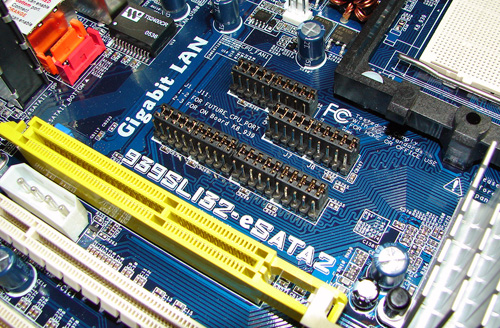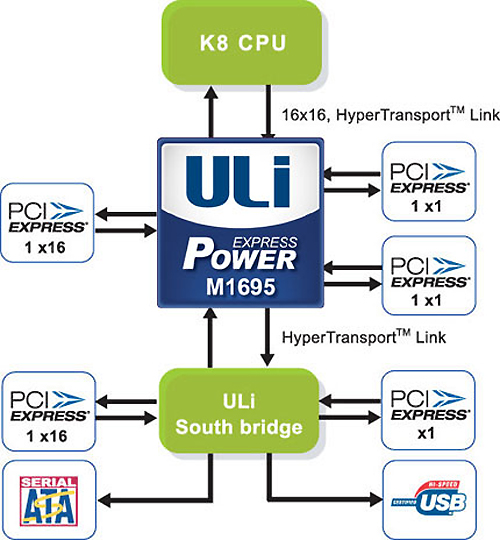ASRock 939SLI32-eSATA2: ULi Dual x16 SLI
by Gary Key on March 2, 2006 12:15 PM EST- Posted in
- Motherboards
"The more alternatives, the more difficult the choice."
This quote by Abbe' D'Allanival conveys our feelings about the ASRock 939SLI32-eSATA2 product. ASRock began operations in 2002 as the value brand group for Asus. ASRock has a history of providing very unique and, at times, unusual products based upon alternative chipsets at inexpensive price points. Although ASRock offers a complete line of products based upon mainstream chipsets from Intel and NVIDIA, it is their products based upon ULi, SIS, and VIA chipsets that are usually far more interesting. More information about the entire line of ASRock products can be found here.The ASRock 939SLI32-eSATA2 motherboard is based on the ULi M1697 and M1695 chipsets. ASRock has done a masterful job in utilizing these recently released chipsets to create a board that might make you think twice about spending any additional money for an NVIDIA nForce4 dual X16 SLI solution. In fact, this board fully supports NVIDIA SLI technology and it works seamlessly with the included ULi PowerExpress Engine Enabling driver although the board is not SLI certified by NVIDIA. Of course, now that NVIDIA has completed their acquisition of ULi, we have to wonder how many manufacturers will be able to provide a similar solution utilizing these chipsets or how long this driver will be available.

During our testing and general usage of the ASRock 939SLI32-eSATA2, we found the board's stability to be exceptional and it delivered competitive results in the latest synthetic and game benchmarks. However, our initial impressions were not as positive at the beginning of the test phase as the board would sporadically produce random results in the synthetic benchmarks while generating lockups in the memory benchmarks. Our issue was with the pre-release test BIOS and was not visible in the production release BIOS on the shipping boards. While the performance of the board was slightly lower in most benchmarks, the stability was superb with the release BIOS.

ASRock utilizes the ULi M1695 HyperTransport PCI Express Tunnel chip for the North Bridge. The ULi M1695 is designed to interconnect seamlessly with other HyperTransport based Host or Bridge chips and, in this case, is interconnected to the ULi M1697 acting as the South Bridge. The M1695 fully supports one PCI Express x16 lane or two x8 lanes for graphics cards and two PCI Express x1 or one PCI Express x4 expansion slot. The M1695 offers transfers of up to 16-bit HTT downstream and 16-bit HTT upstream links at 2.0 GT/s, ensuring an excellent communication path between the processor and connecting bridges.

The ASRock 939SLI32-eSATA2 offers the full complement of options available including two PCI Express x16 connections (fully supports NVIDIA SLI with PowerExpress driver); one PCI Express x4 connection, three 32-bit PCI 2.2 connections, and a unique CPU upgrade port that fully supports the AM2 940-pin CPU with an AM2CPU daughter board. The board also offers HD audio via the Realtek ALC660 HD 5.1 codec, PCI Express Gigabit Ethernet via the Realtek RT8111B PHY, eight USB 2.0 ports (utilizing two USB 2.0 headers), four SATA 3Gb/s connectors, two eSATA 3Gb/s connectors (shared with two SATA 3Gb/s ports), two ATA133 Ultra-DMA IDE connectors, and IEEE 1394 support via the TI TSB43AB22 1394A capable chipset.
Let's find out if this alternative offering leads to a difficult choice.










46 Comments
View All Comments
Gary Key - Saturday, March 4, 2006 - link
It works very well on this board with an Opteron. ;-)Kiste - Thursday, March 2, 2006 - link
In the past, Realtek has solved performance issues by reducing the number of buffers and disabling EAX effects without telling anyone. I hope someone will have a really good look at these integrated audio solutions one day, one that isn't just FPS and CPU utilization.
Gary Key - Thursday, March 2, 2006 - link
To date with the HD Codecs, Realtek has not decreased the buffers nor have we noticed changes in EAX2 output except for the positive. It is a very subjective area to comment on but in BF2 I like the sound quality of the 1.29 drivers better but Serious Sam II seems to have improved a great deal in the 1.30 and 1.31 drivers. While the on-board audio solutions are still lacking in most areas compared to the add-in solutions at least the manufacturers (board/chipset) are trying to improve quality in this area instead of pumping out the same old AC97 codecs. If it were not for the cost I think we would have seen several additional Audigy-SE solutions on the motherboards by now and even possibly an improved offering from Creative. While the A-SE is an older chipset it does offer better performance and audio quality in gaming than the current HD codecs from Realtek, C-Media, ADI, and SigmaTel. I really thought the VIA Envy24 series would have had greater market penetration on the motherboards but one can only speculate as to why this never happened. ;->
tjpark1111 - Thursday, March 2, 2006 - link
is it just me, or does this thing have a 20-pin power connector. ?!?!?!??!???kelim - Thursday, March 2, 2006 - link
Yes, the board does in fact use a 20-pin power connection. If you have a 24-pin PSU, this shouldn't be a problem, since most are 20+4-pin, meaning you can detach the extra 4 pins and only use the ones you need. Either that, or the uneeded pins will hang off the side.Gary Key - Thursday, March 2, 2006 - link
You are correct, it is a 20-pin ATC connector as stated in the article. I was surprised also and did a double take after removing it from the box. :)dab - Thursday, March 2, 2006 - link
It says that this motherboard supports ddr2,"(4) x DIMM, max. 4GB, DDR2 400/333/266, non-ECC, un-buffered memory..."
Is this a joke? There's no 240pin slots on that board, only on the riser (which is not included). s939's IMC doesn't support this either..
Am I mistaken?
Gary Key - Thursday, March 2, 2006 - link
I was just changing that to DDR, sorry about the mistake. The AM2 daughter card will have slots for DDR2 memory.
Puddleglum - Thursday, March 2, 2006 - link
The figure is noteworthy, but it's actually the only Firewire 800 test result I can find in AT's reviews.Gary Key - Thursday, March 2, 2006 - link
I know we only have it in a recent review and probably should drop it. I keep hoping Firewire 800 will be implemented on the higher end boards or those designed for HTPC life. :) However, it appears to be a dead-end option at this point and the technology itself seems to be going away without a fight.